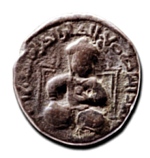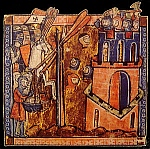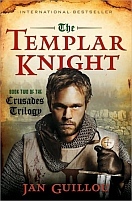Medieval
Fiction
|
|
.
|
|
|

Dirham copper coin showing Saladin,
Mayyafariqin (Silvan/Turkey), 1189-1190 AD

13th century depiction of Siege of Nicaea. Crusaders Throwing Heads Of
Muslims Over Ramparts
"Histoire d'Outre Mer" Guillaume de Tyr.
|

The first headquarters of the Knights Templar, Al Aqsa Mosque, on Jerusalem's Temple
Mount. The Crusaders called it the Temple of Solomon, as it was built
on top of the ruins of the original Temple, and it was from this
location that the Knights took their name of Templar.
Photo credit: Barbara
Kabel
|
|
|
|
Medieval
Book Reviews !
All
Things Medieval !
|
|
The Templar Knight

by Jan Guillou
Now exiled to the Holy
Land for his illicit love, Arn Magnusson has risen in the ranks of the
Knights Templar. Known as Al-Ghouti
among the Saracens, Arn's reputation precedes him. On both sides,
Arn's reputation of strength in battle, intellect and heart gives him
standing not only among his own men, but also those of his enemy.
In
1177, a momentary truce and a chance encounter with Saladin bring sworn
enemies together in ways that will forever change the course of events
and Arn's life. Arn serves as the the master of the Gaza
fortress. As
a Knight's Templar, his duty is more important than his life.
More
important than Gaza is his duty to protect those closer to Jerusalem
and slow down Saladin's march forward. Separated from Cecilia,
the
woman he loves by twenty years of time and miles of distance, his one
hope is to fulfill his sentence of exile. Cecilia lives out her
sentence at a convent back home. While the Crusades rage on
overseas,
another battle, a war between clans, rages within the monastic
walls.
Mother Rikissa uses her position to isolate and punish Cecila, but
Cecilia might just have a few plans of her own in the making. As
Cecilia uncovers the threads of intrigue that led to her exile, she is
more determined than ever to right past wrongs. Living
separately, Arn
and Cecilia both carry each other in their hearts. Will they
survive
their exile and twenty years of exile to be together?
In the second book the Crusades trilogy, Jan Guillou skips over Arn's
rise within the Templar order. The novel begins with a dramatic
opening of Saladin and Arn's chance encounter told from Saladin's point
of view, a point of view that sets the tone for the rest of the
book.
Arn and Saladin discuss philosophy and religion. Arn is a man
deeply
devoted to his religion and his cause, yet he also knows the Koran and
the other side. Rather than demonizing the enemy, he has a keen
sense
of understanding and respect for his opponent. Although the
author's
controversial biography clearly indicates a political bias, in this
novel, the author accomplishes what so few can do with such a
controversial medieval topic as the Crusades. He develops both
sides
of the divide with a wonderful richness and depth without resorting to
the kinds of simplistic caricature often seen. Both men are
devout.
Both men have an honest depth in their religious devotion and their
religious commitment. Both men have a profound sense of
honor. In
contrast to these men, the more fanatical of both groups are seen for
their failings, either their senselessness, unthinking bravado, or
their corruption. Indeed, the battle scenes are all the more rich
and
exciting on account of the author's development of the characters and
their strategies. A sense of the tragic builds throughout the
novel as
fate brings these two men together in a war that pits them against one
another, keeping a reader on the edge of his/her seat.
Cecilia's story alternates with Arn's adventures. Mother
Rikissa is simply wicked, making a wonderful villain and contrast to
those characters whose devotion is genuine. Those unfamiliar with
the
medieval world may find some of her tactics shocking but to those
familiar with some of the period's extremes, her character brings a
sense of authenticity as well as dramatic suspense to the story.
Cecilia's friendships with other scapegoats in the convent reveal her
generosity, her ingenuity, and her daring of character. Cecilia's
battle against Mother Rikissa is just as suspenseful as Arn's.
One
reinforces the other. Like Arn, now Cecilia moves from a place of
innocence and naivete to that of a more mature and accomplished woman.
THE TEMPLAR KNIGHT is an exquisite installment in this medieval epic
heroic trilogy. Again, Jan Guillou incorporates the
history of
the time with the literary themes of arms, religion and romance so
loved by medieval literature enthusiasts. Lovable
characters become even more lovable. The second installment
develops
the details of the plotting behind Arn and Cecilia's separation.
Whereas the first book, THE ROAD TO JERUSALEM, focused on Arn's youth
and innocence, here in THE TEMPLAR KNIGHT, readers see the hero as a
mature man in the midst of his accomplishments. Although each
book can
be read as a stand alone, I highly recommend reading both books
together. Although different in tone, together, these two
books build
the sweeping epic tone of trilogy. One book is not just a rehash
of
the other. The emotional tone of each varies, the hero' and
heroine's
age and vision change, and history itself moves forward. Once
again,
the translator has done an excellent job rendering this story into
flowing English and expertly handling the dramatic changes in point of
view. Medievalist or not, if you love tales of arms,
religion and romance, this trilogy is not to be missed. If,
like me, you love all things medieval, THE TEMPLAR KNIGHT and its
predecessor THE ROAD TO JERUSALEM, are absolute must reads.
OUTSTANDING! This reader eagerly awaits the too far off final
installment!
Publisher: Harper
(May 4, 2010)
Other books in The Crusades trilogy: The Road to Jerusalem (April
2009), The Kingdom
at the End of the Road (summer 2011)
Translator: Steven T. Murray
Publisher: Harper
(April 21, 2009)
Other books in the trilogy: The Templar Knight (May 2010), The Kingdom
at the End of the Road (summer 2011)
Translator: Steven T. Murray
|
Book description
A knight in the Holy Land.
A woman in the frozen north.
A war that kept them apart . . .
Exiled to the Holy Land for two decades, Arn
Magnusson has risen in the ranks of the Knights Templar, serving as
master of the order's Gaza fortress. Among the last bastion of God's
holy warriors determined to save Jerusalem from the Muslims, Arn has
cultivated a shrewd understanding of his enemy. Known as Al-Ghouti
among the Saracens—Saladin and his Muslim followers—he is renowned as a
man of compassion, strength, and faith.
Yet neither time nor distance can lessen the pain
of separation from his beloved Cecilia. Confined to a cloister back
home in western GÖtaland, Arn's betrothed is a pawn in a war
between clans vying for control of the crown. Yearning for him and
their newborn son, who is being raised by relatives, Cecilia must also
endure the cruelties of a vindictive abbess from a rival clan.
When an accident of fate brings together Arn and
Saladin, a friendship is forged that will alter the course of the
Templar knight's life, and the history of Jerusalem itself. After the
bloody Battle of Hattin, Arn finally becomes a free man. But the road
home is long and treacherous, and he is uneasy about the fate that
awaits him and uncertain whether his betrothed still lives.
Broadening the scope of Arn's epic path to
redemption, The Templar Knight continues the story of the
founding of a nation—and of the warrior and the love that made it
possible.
|
|
|